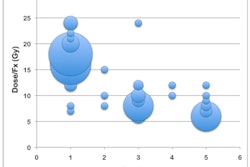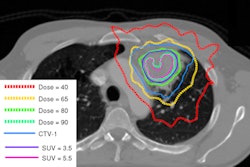Stereotactic body radiation therapy (SBRT) is producing impressive rates of local control for malignant lung and liver lesions. An article published in the July issue of the International Journal of Radiation Oncology, Biology, Physics identifies dose-volume parameters that predict the risk of chest-wall toxicities for these patients.
Radiation oncologists at Indiana University School of Medicine analyzed the medical records of 311 patients who received SBRT between 2000 and 2008. A total of 347 lesions received treatment, of which 160 were lung chest-wall lesions and 43 were liver chest-wall lesions (Int J Radiat Oncol Biol Phys, Vol. 80:3, pp. 692-697).
Toxicities occurred from the treatment of 42 chest-wall lesions, or 20.7% of the 203 total number of chest-wall lesions. For these lesions, the frequencies of rib fracture and chest-wall pain were 8% and 16%, respectively
Toxicities also occurred from the treatment of nonchest-wall lesions, but at a much lower frequency: five of the total 144, or 4%. For these lesions, the rates of rib fracture and chest-wall pain were 1% and 3%, respectively.
The time to develop these chest-wall toxicities also differed between the two types of lesions, with chest-wall lesion toxicities occurring much more rapidly, at a median of eight months, compared with 14 months for nonchest-wall lesions. In 23 (49%) of 47 instances of chest-wall toxicity, patients required prescription pain relief.
The researchers observed a gradual increase in risk of toxicities as dose and volume increased, according to lead author Dr. David Andolino, of the department of radiation oncology, and colleagues. As an example, the group determined that the volume of the chest wall receiving 15 to 40 Gy was highly predictive of toxicity, with a 10% risk of at least grade 1 toxicity when 5 cc of the chest wall received 40 Gy, and a 30% risk when 15 cc received 40 Gy.
The group identified 50 Gy as the cutoff for the maximum dose to the chest wall and rib. With greater doses, there was a significant increase in the frequency of any grade of pain and fracture.
A surprising finding was that 61% of all rib fractures were asymptomatic, diagnosed only through routine imaging. In addition, only 19% of all instances of chest-wall pain were associated with rib fractures. The research team suggested that peripheral nerve damage may be the primary cause of chest-wall discomfort following SBRT treatment, rather than direct rib injury.



















